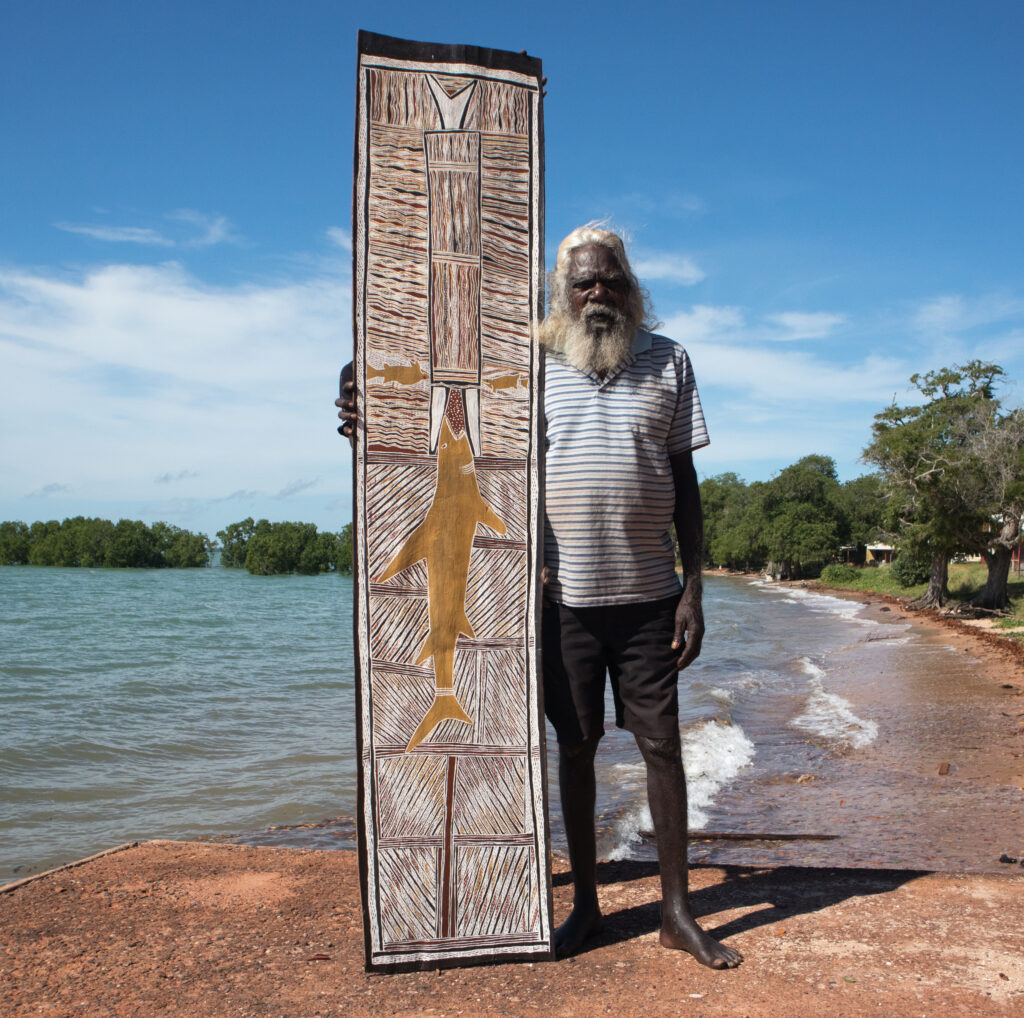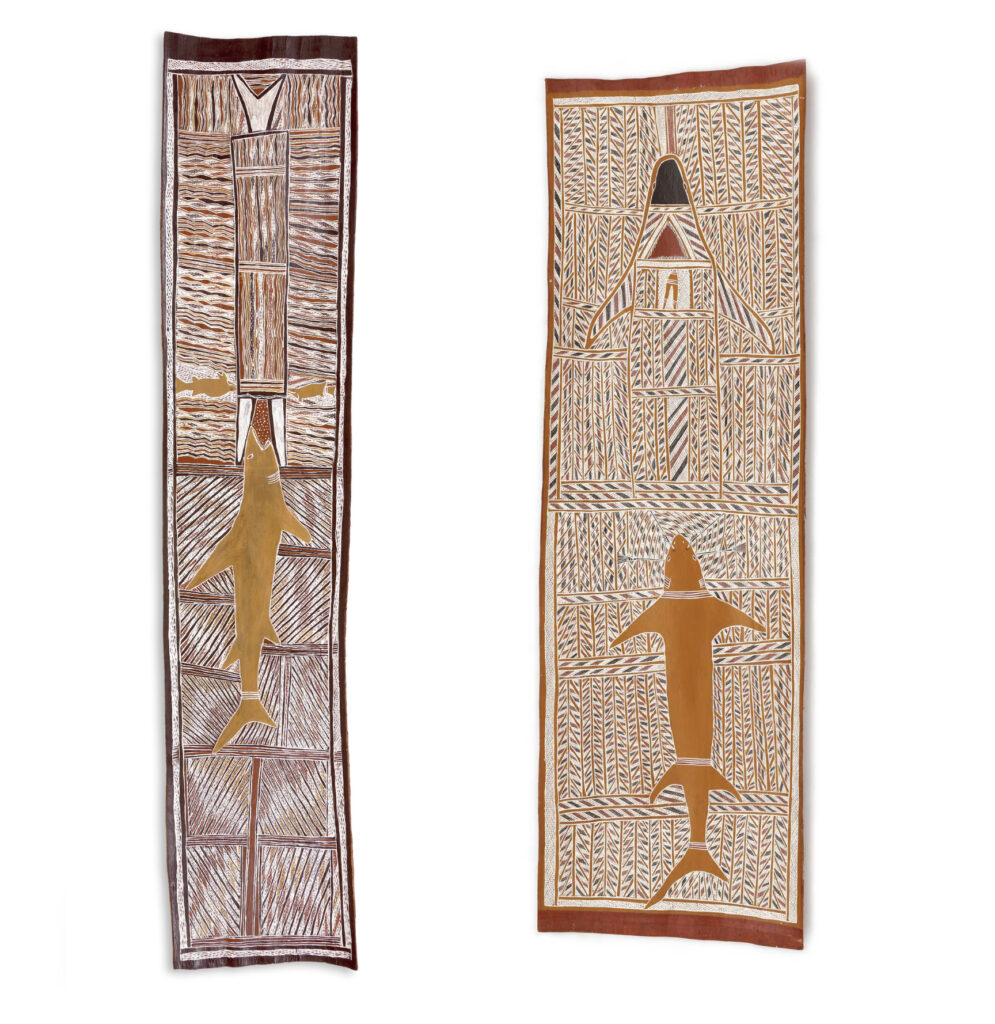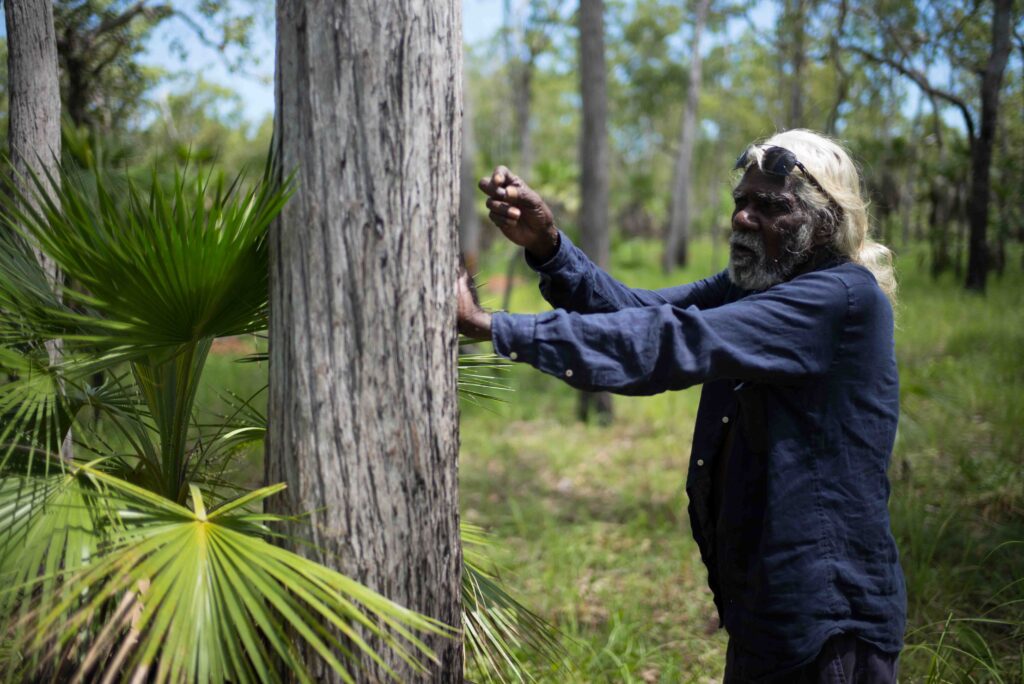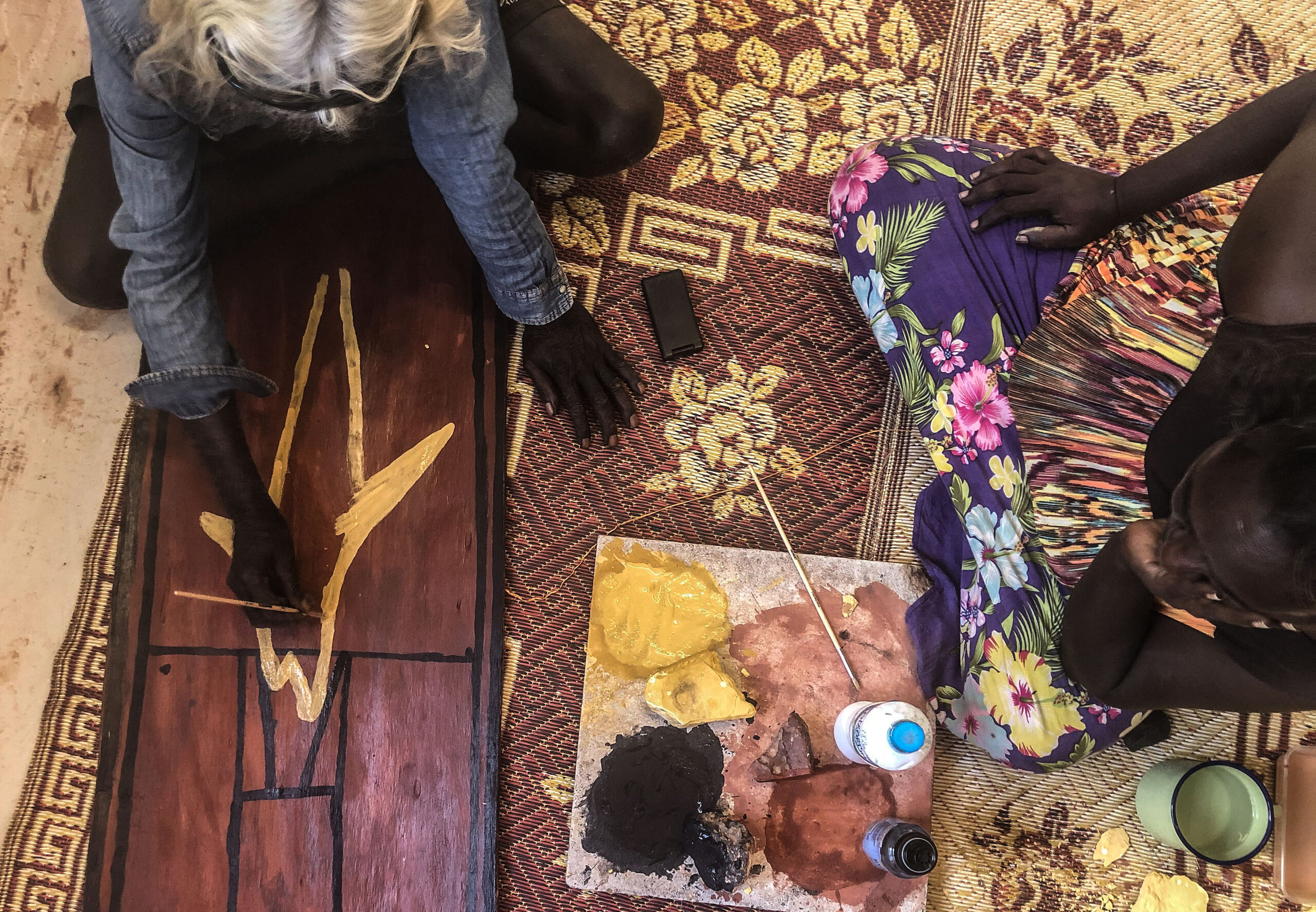
Wilson Manydjarri Ganambarr is an artist, song man and an important elder. He is the current leader of the Ḏäṯiwuy clan and ceremonial caretaker for a number of related clans throughout North Eastern Arnhem Land. A humble man of great knowledge, Manydjarri lives in Milingimbi and regularly travels between Yirrkala, Galiwin’ku (Elcho Island) and his homeland of Rorruwuy to undertake ceremonial duties. He is responsible for the ceremony, law and designs of his mother’s, father’s and mother’s mother’s clans.
This month sees the long-awaited opening of MAḎAYIN: Eight Decades of Aboriginal Australian Bark Painting from Yirrkala, presented by the Kluge-Ruhe Aboriginal Art Collection of the University of Virginia. The major exhibition features two extraordinary works by Manydjarri and his father, Muwarra Ganambarr amongst an ambitious collection of 90 important barks from artists from Yirrkala and surrounding homelands. MAḎAYIN will tour through the United States until 2024, beginning with the Hood Museum at Dartmouth, September 3- December 4, 2022.
In 2021, Manydjarri generously shared the stories of the clan designs featured in these works which was transcribed and translated by Milingimbi Art and Culture’s Djalkiri Keeping Place team for the exhibition and the community’s archives.
The story of Mäṉa ga Dhukururru (Ancestral Shark and Sacred Rock), which appears in the exhibition catalogue, is reprinted below.

STORY
Ancestral Shark and Sacred Rock (Mäṉa ga Dhukururru)
as told by Wilson Manydjarri Ganambarr
“Now this story – [the story] of my place, this is a big name place: Buḻurruma Ḻukuḻuku, [also known as] Galthunmirri Galdhaḏipa. Yes. That place, called Rinydjalŋu, belongs to a troublemaker. In this picture, he was alive, travelling from there, and he’s alive now – he’s still there, going around.
Alright. He was there, he was there at his place and he heard it coming down. Guḻarri, from Dhäliny, from that place. [From] Muṯuwili, [from] Dhanaraŋala Guyambiyambi. [The Yirritja water] was singing out the songlines. He called it out, “dhaaaaa o!” What was it carrying as it went along? The kernals of cycad nuts. Cycad nuts, cycad you know, that we pound, in a bag, in a dillybag, a ŋaḻiwarrkarr, in [a stringbag known as] a ŋurrmiri.
Alright. [The stone] came along and planted its legs [on the ground], the legs of the stone, the sacred rock. So it came downstream with this [stone]. He was heard by this one [the shark], “Hey, what’s this?”, he said. I spoke, the Ḏätiwuy [clan], I am Ḏäṯiwuy, and this is my Ḏäṯiwuy shark. The shark. And he said, “What is this, coming downstream? It’s singing the songlines…What’s it bringing downstream?” He was listening. [The Yirritja water] was travelling down, singing out the songlines, “Gaaaaa o! Mm mm”, the ḏalkarra was singing. Yes. It was coming down. [The water] was coming down and the shark spoke. They had the feeling they wanted to talk, like we talk together, they wanted to talk.
Maybe it was like this: God made the places. They were talking together, these creation beings of ours. These two were in conversation, this Wangurri water, and the Dhuwa [shark]. Coming downstream. “Who are you, coming downsteam?” “I, am coming down. Me, here, I’m coming downstream. Bewaḻi Djambaḻmurru Giyambiyambi Guṉinymurru Muṯuwili. I’ve come from a long way away, Burrayŋuru Burrawaṉdji Ḻätharra Momana ŋunha Warkawarka”, it said, naming all the Ritharrŋu places. “I’m carrying this from there, my Yirritja knowledge and memory. These things of mine Gayarrwayil and Muŋuwili, Djirrkura and Mandawuy from Dhurrwaraḻapa Guninymurru Dhanaraŋala.” That’s what this Yirritja water here said.
Alright. Then this one [the shark] said, the shark spoke, he said to him, putting his head down… He stopped at first. “I’ve been lying here waiting for you. I’ve put my head down. Mother, climb onto my head. That water. Stand over my head with your legs, stand on my head.” That is what he said. “Don’t cover up my eyes”, said [the shark], “Don’t cover my eyes with the dirty water. I need to watch. I’m a trouble-maker. I come from Buḻurrma. Galdaḏipa is my place. Climb on my head and pass through”, said [the shark]. Like that, everything came downstream for them, everything, all of the inheritance [of the Dhuwa and Yirritja], all of their things, they were together, mother, and child. [Those things] came downstream. That’s how it is.
The Dhuwa and Yirritja water travelled together all the way down to that area called Yinyikay. That island, it’s there. The water looked back, “Hey, Mother, my home is so far away. Martjirra Yiniwuḻma Buruŋgay, my country… has become calm. My mud place is a long way away”, he said – the Dhuwa water said. “Ok, go on then, go back, I’ll go downstream alone”. It sings. “I’m looking, I have to look for something. I have to reach the deep ocean, Gurinyal Gawarrkawarr”, it said – this one [the Yirritja water]. So it continued on, all the way, the water. That’s how the story goes.
For these two – there’s one water for these two, mother, and Dhuwa [her child]. The water comes downstream from the back-country, from Garaŋga, and it comes from there, downstream. Dirty water. Yes. That’s the story for those two, for Wangurri and Ḏäṯiwuy. And and between those two [the country] is Ŋaymil. Yes. That’s how the story goes.”

Ga dhuwal dhäwu – ŋarrakuwuynha wäŋa, wäŋa ŋayi ŋunha yindi: Buḻurruma Ḻukuḻuku, Galthunmirri Galdhaḏipa. Yow. Wäŋa ŋayi dhuwal Rinydjalŋu wäŋa ŋunha melmariw. Dhuwal wuŋuli, walŋa yan beŋur bili, ga dhiyaŋbala walŋa yan ŋunha, ŋorra ŋayi yukurra garaŋga ŋorra.
Manymak. Ŋorran ŋayi, wäŋaŋur, ŋäku ŋayi dhunarran. Guḻarri, Dhälinyŋur wäŋaŋur. Muṯuwili Dhanaraŋala Guyambiyambi. Birkarr’wirka’yurr ŋayi marrtjin dhä-riŋgitj. Ŋurrkaŋal, “dhäaaaa o!” Gäŋal ŋayi marrtjin nhä? Mari ganiwu gayalpaḏi. Ḏingu, ḏingu ŋuli wutthuna, bathimirr, bathimirr ŋaḻiwarrkarrmirr, ŋurrmirimirr.
Manymak. Mulkan ŋayi nhirrpara ŋayi ganaŋga nhanŋu nherrana, ganaŋga birayŋu, dhukururru. Bala ŋayi dhunarrany marrtjin dhiyakumirrnha. Ŋäku ŋayi dhiyaŋuny, “Way, nhä dhikayi?” bitjarr. Ŋarra waŋan, Ḏäṯiwuy. Ŋarra Ḏäṯiwuy dhuwal, ga Ḏäṯiwuy ŋarraku dhuwal mäṉa. Buḻ’manydji. Bala ŋayi waŋan bitjarr, “Nhä dhika ŋarrak marrtji dhunarra?” “Birkarr’wirkarr’yun ŋayi marrtji dhä-riŋgitj…Dhuwal nhä ŋayi marrtji gämany?” Bitjan ŋayipi ŋäkul gan. Ŋayi marrtjin yarrgupthurr, dhurrwara ŋurrkaŋal, “Gaaaaa o! mm mm”, ḻakaram ŋayi marrtji ḏalkarra. Yow. Waṉḏin ŋayi. Waṉḏin ŋayi, ŋayi waŋan dhuwal. Balanya maṉḏaŋ gan ŋunhi nhawi ŋayaŋu ŋorran nhakun dhiyaŋ bala yolŋu limurr ga waŋanhamirr, ŋilimurru.
Mak walal ŋunhi gan bitjarrdhi bili ŋunhi: Goddhu made wäŋa. Walal gan ŋunhi waŋanhamin dhuwali ŋunhi waŋarr mala ŋalimurruŋ. Mäṉḏa gan ŋunhi waŋanhamin, dhuwal gapu Wangurri,
ga Dhuwa [shark]. Dhunarranan. “Nhä nhe dhika yarrgupthun marrtji?” “Ŋaya ŋarru dhaŋu dhuniya. Ŋaya gayiŋa, ŋaya ŋarru dhuniya dhaŋu. Bewaḻi Djambaḻmurru Giyambiyambi Guṉinymurru Muṯuwili. Bäkam ŋaya ŋunhawaḻi, Burrayŋuru Burrawaṉdji Ḻätharra Momana ŋunha Warkawarka”, bitjarr. Ŋunha wäŋa ḻakaraŋal Ritharrŋu. “Dhaŋum ŋaya gayiŋa baṉgala, dhaḻatj nyäkuway. Nyäkuway ŋaya ŋarru Gayarrwayil ga Muŋuwili, Djirrkura ga Mandawuy waŋgalaŋur Dhurrwaraḻapa Guṉinymurru Dhanaraŋala.” Bitjarr ŋayi waŋan dhuwal gapu dhuwal gapu Yirritja.
Manymak. Ŋayi dhuwan waŋan, dhuwal buḻ’manydji waŋan, bitjarr ŋayi nhanŋu, buku waḻapthurr… Galmuŋal ŋayi nhanŋu ŋäthil “Gu ŋarra nhuŋu dhiyal ŋorra, ŋäthil. Waṉḏa ŋarra nhuŋu gurrupanmirr. Ŋäṉḏi, ŋal’yurr ŋarrakal bukulil. Gapu dhuwali. Ḏapthunmaraŋal ganaŋgay dämbu ŋarrakal waṉḏalil ŋal’yurr.” Bitjarr ŋayi waŋan dhuwal. “Djirrkurul ŋarrany yaka munygum”, bitjarr, “Maŋutji ŋarrany yaka munygum nhe ganuy. Dhuwal ŋarra yukurra waṉ’thun.
Mel-mari wanaŋa-gurriri. Wäŋawuy Buḻurrma Galdaḏipa ŋarrakuwuy dhuwal wäŋa. Ŋal’yurr ŋarrakal marrtji dhunarrany”, bitjarr. Bala ŋunhidhiny maṉḏaŋ ŋunhi rrambaŋi dhunarrany, gapu,
everything maṉḏak, maḏayin’ mala, ŋunha nhä malany thing ŋunhi, rrambaŋi maṉḏany ŋäṉḏi,
ga yothu. Yarrgupthurr ŋayi marrtjin. Balanya.
Marrtjinany maṉḏa rrambaŋi gaya galki ŋurrkanhawuy dhuwal nhawiŋur Yinyikay wäŋa. Dhakal, ŋayi ŋunhiyidhi ŋayi. Nhäŋalnha ŋayi gapu, “Way, Ŋäṉḏi, ŋarrakuwuy ŋunhan wuyupthunan dhawal. Martjirra Yiniwuḻma Buruŋgay, ŋarrakuwuy ŋunha… buṉwulkthunan. Barrku ŋunha ŋarrakuwuy wapaṉgi raŋi”, bitjarr ŋayi, gapu waŋan, Dhuwa. “Yow. Gatju ḏirruwan, ŋayapin ŋarru dhuniya”. Birkarr’wirkarryun. “Rangam ŋayiŋa, Rangam ŋaya ŋarru, Ŋarra ŋaya ŋarru ṉuku ŋayatham Gurinyal ŋunha Gawarrkawarr”, bitjarr ŋayi dhuwal. Baḏaknha ŋayi yukurra marrtjinany ŋarkula. Balanya dhäwu.
Dhuwal maṉḏak – gapu maṉḏak waŋgany, ŋäṉḏi, ga Dhuwa. Ŋayi ŋuli dhunarra marrtji Garaŋgaŋur gapu, ga ŋayi ga marrtji beŋur, dhunarra. Mel-wanhdhurrmirr. Yow. Dhuwal dhäwuny maṉḏakuny, Wangurri ga Ḏäṯiwuy. Ga between ŋunhi maṉḏakal Ŋaymil.
-Transcribed and translated from Dhuwal by Wilson Manydjarri Ganambarr, Abigail Mundjala and Salome Harris, 2021
For more about MAḎAYIN: Eight Decades of Aboriginal Australian Bark Painting from Yirrkala and to see the complete exhibition online head to the exhibition webpage at https://madayin.kluge-ruhe.org/
Click here for more information about Wilson Ganambarr Manydjarri
